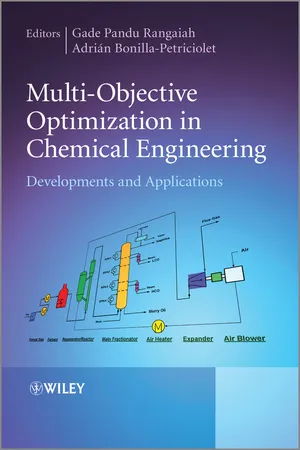![]()
Part I
Overview
![]()
1
Introduction
Adrián Bonilla-Petriciolet1 and Gade Pandu Rangaiah2
1Department of Chemical Engineering, Instituto Tecnológico de Aguascalientes, Aguascalientes, Mexico
2Department of Chemical and Biomolecular Engineering, National University of Singapore, Singapore
1.1 Optimization and Chemical Engineering
Optimization is important for process modeling, synthesis, design, operation and retrofitting of chemical, petrochemical, pharmaceutical, energy and related processes. Usually, chemical engineers need to optimize the design and operating conditions of industrial process systems to improve their performance, costs, profitability, safety and reliability. Process system optimization is challenging because chemical engineering application problems are often complex, nonlinear and large, have both equality and inequality constraints and/or involve both continuous and discrete decision variables. The mathematical relationships among the objective to be optimized (also known as the performance criterion), constraints and decision variables establish the difficulty and complexity of the optimization problem, as well as the optimization method that should be used for its solution. In particular, the type of search space (i.e., continuous or discrete), the properties of the objective function (e.g., convex or non-convex, differentiable or nondifferentiable), and the presence and nature of constraints (e.g., equality or inequality, linear or nonlinear) are the principal characteristics to classify an optimization problem (Biegler and Grossmann, 2004).
The classes of optimization problems commonly found in engineering applications include linear programming, quadratic programming, nonlinear programming, combinatorial optimization, dynamic optimization, mixed integer linear/nonlinear programming, optimization under uncertainty, bi-level optimization, global optimization and multi-objective optimization (Floudas, 2000; Diwekar, 2003; Biegler and Grossmann, 2004; Floudas et al., 2005). These types of optimization problems are found in almost all application areas such as modeling, synthesis, design, operation and control of chemical and related processes, and a wide variety of numerical methods have been used to solve them (e.g., Luus, 2000; Edgar et al., 2001; Tawarmalani and Sahinidis, 2002; Diwekar, 2003; Biegler and Grossmann, 2004; Grossmann and Biegler, 2004; Floudas et al., 2005; Ravindran et al., 2006; Rangaiah, 2009 and 2010).
Application problems may have multiple optima, and it may be essential to find the global optimum or the best solution. Depending on their convergence properties, optimization methods can be classified as local or global. They may also be classified as deterministic or stochastic methods depending on whether their search is deterministic (often using gradient of the objective function and other properties of the problem) or stochastic (employing random numbers). Local methods are computationally efficient and suitable for finding a local optimum. These search strategies have been exploited commercially as can be seen from their implementation in common software and process simulators such as Solver tool in Excel, optimization tool-box in Matlab, GAMS, Aspen Plus and Hysys. Current progress in computational capabilities has prompted an increasing and considerable attention on the incorporation of global optimization methods in commercial software. For example, an evolutionary search engine is now available in the Solver tool. Global methods are more likely to find the global optimum.
To date, research contributions in optimization for chemical engineering have focused primarily on theoretical and algorithmic advances including the development of reliable and efficient strategies and their application for solving challenging and important chemical engineering problems. The majority of these contributions deal with optimization problems having only one objective function. In general, optimization problems in chemical engineering and in other disciplines involve more than one objective function related to performance, economics, safety and reliability, which have to be optimized simultaneously since these objective functions may be fully or partially conflicting over the range of interest. Examples of conflicting objectives are: capital investment versus operating cost; cost versus safety; quality versus recovery/cost; and environmental impact versus profitability. Multi-objective optimization (MOO), also known as multi-criteria optimization, is necessary to find the optimal solution(s) in the presence of tradeoffs among two or more conflicting objectives.
Multi-objective optimization has therefore been studied and applied to solve a variety of challenging and important problems in chemical engineering (Bhaskar et al., 2000; Rangaiah, 2009; Chapter 3 in this book). In a perspective paper on issues and trends in the teaching of process and product design, Biegler et al. (2010) noted that an important goal in process design is optimization for multiple objectives such as profit, energy consumption and environmental impact. In another perspective paper on sustainability in chemical engineering education, identifying a core body of knowledge, Allen and Shonnard (2012) have included process optimization as one of the computer-aided tools for environmentally-conscious design of chemical processes; within process optimization, they have listed multi-objective, mixed integer and nonlinear optimization. Both these perspectives from eminent researchers attest the growing importance and need for MOO in chemical engineering.
Even though research in the application of MOO in engineering has grown significantly, there is only one book specifically devoted to MOO techniques and their applications in chemical engineering (Rangaiah, 2009); it describes selected MOO techniques and discusses many applications. MOO and its applications are growing with new developments and interesting applications being reported continually. The present book covers the most recent developments in MOO methods and novel applications of MOO for modeling, design and operation of chemical, petrochemical, pharmaceutical, energy and related processes. In short, the present book complements the previous book on MOO in chemical engineering. The remainder of this chapter is organized as follows. Section 1.2 provides the basic concepts and definitions used in MOO. Section 1.3 discusses MOO briefly in the context of chemical engineering. Finally, section 1.4 presents an overview of all the chapters in this book.
1.2 Basic Definitions an...
